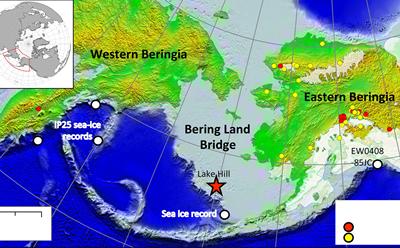Climate shift may have spurred migration across now submerged land bridge

A new study by Canadian, UK and US researchers has found that climate conditions shifted to become wetter and warmer around 15,000 years ago and contributed to the first human migration between Asia and North America.
A stretch of land known as the Bering Land Bridge once connected what is today Russia and Alaska, when sea levels were much lower during the last glaciation. This was an important bridge because it provided an opening for the dispersal of people and animals from Asia into the Americas.
Led by University of Alaska Fairbanks (UAF), working with geographers at the University of Southampton (UK), the research team was able to gauge climate conditions by studying a 12-metre-long sediment core collected from a lake on St. Paul Island in the Bering Sea.
By analysing organisms in the core, scientists constructed a climate record of the Bering Land Bridge during the past 18,500 years. Almost all of the bridge and evidence of its past conditions is now submerged due to sea level rise.
The study, which also involves the universities of Arizona, Pennsylvania State, Wisconsin-Madison, Mount Allison, New Brunswick, York (Canada) and Plymouth (UK), is published in the journal Royal Society Open Science.

Professor Peter Langdon, Head of Geography at the University of Southampton, comments: “Developing independent climate records are vital for testing theories relating to historic human migration. The temperature record we generated changed significantly at the time when the first humans appeared in Alaska.”
“We provide a temperature record pretty much from the centre of the now-submerged land bridge,” says UAF Professor of Marine Biology Matthew Wooller, director of the Alaska Stable Isotope Facility and lead author of the study. “This is a really unique record because of its location and length.”
The researchers were able to show shifting climatic conditions in the past by examining fossils from bugs, plants and spores in the sediment core. Many of these organisms live in specific conditions, so their presence offers evidence about past temperatures and moisture levels.
A marked climate shift to wetter, warmer conditions coincides with the earliest appearance of humans in Alaska. Scientists have found archaeological evidence that dates human habitation in the area as far back as 14,200 years ago. This climate shift likely meant a transition from steppe (flat grassland) to forests in Eastern Beringia during this time. Meanwhile, horses declined in interior Alaska as moose appeared, which could have affected human hunting practices and food availability.
Scientists have long debated the factors that contributed to human migration to North America, but this study provides reasons to strongly consider environmental factors among those that ‘pushed’ people eastward from Asia into the Americas, according to UAF Associate Professor of Anthropology Ben Potter, who contributed to the research.
“To me, this is a springboard for many new ideas,” says Potter. “While recent findings from genetics reveal a complex record of population history, studies like this are important to understand the ecological reasons for human migration.”
